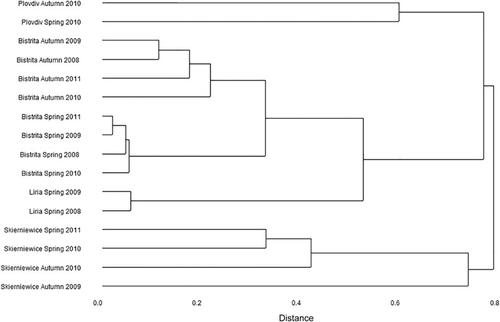当前位置:
X-MOL 学术
›
Ann. Appl. Biol.
›
论文详情
Our official English website, www.x-mol.net, welcomes your feedback! (Note: you will need to create a separate account there.)
Statistical model for Plum pox virus prediction in Prunus nursery blocks using vector and virus incidence data in four different European ecological areas
Annals of Applied Biology ( IF 2.6 ) Pub Date : 2020-07-02 , DOI: 10.1111/aab.12617 Eduardo Vidal 1, 2 , Luminita Antonela Zagrai 3 , Tadeusz Malinowski 4 , Grażyna Soika 5 , Wojciech Warabieda 5 , Elena Tasheva‐Terzieva 6 , Snezhana Milusheva 7 , Ioan Zagrai 3 , Ivanka Kamenova 8 , Valentina Bozhkova 7 , Carmen Martínez 1 , María Cambra‐López 9 , Mariano Cambra 1
Annals of Applied Biology ( IF 2.6 ) Pub Date : 2020-07-02 , DOI: 10.1111/aab.12617 Eduardo Vidal 1, 2 , Luminita Antonela Zagrai 3 , Tadeusz Malinowski 4 , Grażyna Soika 5 , Wojciech Warabieda 5 , Elena Tasheva‐Terzieva 6 , Snezhana Milusheva 7 , Ioan Zagrai 3 , Ivanka Kamenova 8 , Valentina Bozhkova 7 , Carmen Martínez 1 , María Cambra‐López 9 , Mariano Cambra 1
Affiliation

|
Plum pox virus (PPV) is the causal agent of sharka, the most devastating virus disease of Prunus species. PPV is transmitted by vegetative propagation, particularly by grafting, as well as by aphid species in a nonpersistent manner. The objective of this paper was to evaluate the prevalence and diversity of PPV‐vector aphid species in representative European areas of prunus cultivation. Four experimental nursery plots were established in Skierniewice (Poland), Liria (Spain), Plovdiv (Bulgaria) and Bistrita (Romania). Aphid population was weekly monitored using the sticky shoot method in spring and/or autumn in each nursery plot. Furthermore, we estimated the relative efficiency factor for the main PPV‐vector aphid species using bibliographic and reference data. Aphid diversity in each nursery plot was assessed using the Shannon index and the number of estimated aphid species was calculated by the rarefaction method. The highest diversity of aphid species population was reported in Plovdiv in spring while the lowest diversity was found in Liria in spring. A cluster analysis based on Morisita–Horn similarity index was performed to study the differences in species composition between the four nursery plots and seasons. Aphid population was clearly grouped by location and season. Results showed Aphis spiraecola and Hyalopterus pruni complex were typically spring aphid species, while Anoecia corni and Rhopalosiphum padi dominated autumn catch. Regarding PPV‐vector aphid species present in nursery plots, A. spiraecola was the most prevalent PPV‐vector aphid species in Liria and in Bistrita, showing a high relative efficiency factor of PPV transmission (0.91). Consequently, A. spiraecola should be considered a key actor in the spread of PPV in these regions. Hyalopterus pruni complex was the most prevalent PPV‐vector aphid species in Skierniewice and Plovdiv, showing a very low relative efficiency factor of PPV transmission (0.09). Therefore, the role of H. pruni complex in spread of PPV in these regions can be considered negligible. Furthermore, we statistically demonstrated that the presence of specific PPV‐vector aphid species is associated with the spread of the disease, whereas the biodiversity of aphid species population does not affect the spread of PPV. Finally, the advantages of the use of vector pressure index in the management of sharka disease are discussed.
中文翻译:

利用欧洲和欧洲四个不同生态区域的病媒和病毒发病率数据预测李子苗圃区的李子痘病毒的统计模型
李子痘病毒(PPV)是沙尔卡病毒的致病因子,沙尔卡病毒是最致命的李子病毒病种类。PPV通过营养繁殖(尤其是通过嫁接)以及蚜虫物种以非持久方式传播。本文的目的是评估在欧洲有代表性的李子栽培地区PPV-载体蚜虫种类的流行和多样性。在Skierniewice(波兰),Liria(西班牙),Plovdiv(保加利亚)和Bistrita(罗马尼亚)建立了四个实验苗圃地。在每个苗圃地,在春季和/或秋季使用粘芽法每周监测蚜虫种群。此外,我们利用书目和参考数据估算了主要PPV-载体蚜虫种类的相对效率因子。使用香农指数评估每个育苗区的蚜虫多样性,并通过稀疏法计算估计的蚜虫种类数量。据报道,春季普罗夫迪夫的蚜虫物种多样性最高,而春季的里里亚则最低。进行了基于Morisita-Horn相似性指数的聚类分析,以研究四个苗圃地和季节之间物种组成的差异。蚜虫种群明显按位置和季节分组。结果显示棉蚜spiraecola和桃粉pruni复杂的是典型的春季蚜虫,而Anoecia山茱萸和禾谷缢管蚜为主的秋季捕捞。关于苗圃中存在的PPV载体蚜虫种类,螺旋藻是利里亚和Bistrita中最普遍的PPV载体蚜虫种类,显示了PPV传播的相对效率高(0.91)。因此,螺旋藻应该被认为是PPV在这些地区传播的关键因素。Hyeropterus pruni复合物是Skierniewice和Plovdiv中最普遍的PPV载体蚜虫种类,显示PPV传播的相对效率系数非常低(0.09)。因此,作用在这些地区中PPV传播中的H. pruni复合体可以忽略不计。此外,我们从统计学上证明,特定PPV-载体蚜虫物种的存在与疾病的传播有关,而蚜虫物种种群的生物多样性并不影响PPV的传播。最后,讨论了使用矢量压力指数在沙卡病管理中的优势。
更新日期:2020-07-02
中文翻译:

利用欧洲和欧洲四个不同生态区域的病媒和病毒发病率数据预测李子苗圃区的李子痘病毒的统计模型
李子痘病毒(PPV)是沙尔卡病毒的致病因子,沙尔卡病毒是最致命的李子病毒病种类。PPV通过营养繁殖(尤其是通过嫁接)以及蚜虫物种以非持久方式传播。本文的目的是评估在欧洲有代表性的李子栽培地区PPV-载体蚜虫种类的流行和多样性。在Skierniewice(波兰),Liria(西班牙),Plovdiv(保加利亚)和Bistrita(罗马尼亚)建立了四个实验苗圃地。在每个苗圃地,在春季和/或秋季使用粘芽法每周监测蚜虫种群。此外,我们利用书目和参考数据估算了主要PPV-载体蚜虫种类的相对效率因子。使用香农指数评估每个育苗区的蚜虫多样性,并通过稀疏法计算估计的蚜虫种类数量。据报道,春季普罗夫迪夫的蚜虫物种多样性最高,而春季的里里亚则最低。进行了基于Morisita-Horn相似性指数的聚类分析,以研究四个苗圃地和季节之间物种组成的差异。蚜虫种群明显按位置和季节分组。结果显示棉蚜spiraecola和桃粉pruni复杂的是典型的春季蚜虫,而Anoecia山茱萸和禾谷缢管蚜为主的秋季捕捞。关于苗圃中存在的PPV载体蚜虫种类,螺旋藻是利里亚和Bistrita中最普遍的PPV载体蚜虫种类,显示了PPV传播的相对效率高(0.91)。因此,螺旋藻应该被认为是PPV在这些地区传播的关键因素。Hyeropterus pruni复合物是Skierniewice和Plovdiv中最普遍的PPV载体蚜虫种类,显示PPV传播的相对效率系数非常低(0.09)。因此,作用在这些地区中PPV传播中的H. pruni复合体可以忽略不计。此外,我们从统计学上证明,特定PPV-载体蚜虫物种的存在与疾病的传播有关,而蚜虫物种种群的生物多样性并不影响PPV的传播。最后,讨论了使用矢量压力指数在沙卡病管理中的优势。



























 京公网安备 11010802027423号
京公网安备 11010802027423号